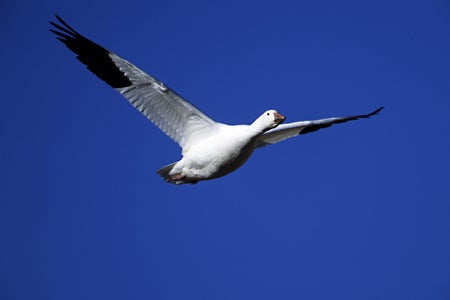SCIENTIFIC NAME:
Chen caerulescens
OTHER NAMES:
Blue Goose, Brant
STATUS:
Fairly common to uncommon in winter and fall in Tennessee Valley and Mountain regions, but rare in summer. Uncommon to rare in winter, spring, and fall in other regions. Lowest Conservation Concern.
DESCRIPTION:
Thesnow goose (Chen caerulescens) is a medium sized goose which has two color phases. Birds with the dark plumage are more commonly known as a blue goose. The light plumage is present on the more recognizable namesake or snow goose. The following characteristics are present on both color phases: white head and neck, pink bill with a black “grinning patch”, rosy red feet and legs, and black primaries (wing tips). The wing coverts and body of the blue phase is slate grey with a varying amount of white on the belly. The white phase has snow white wing coverts, body, and belly.
DISTRIBUTION:
Chen caerulescens have doubled in number since the mid-1970’s and are the second most populous geese in North America, behind Canada geese. Snow geese are migratory birds that breed in Artic regions of northern Canada and eastern Siberia. During early fall, the geese migrate to central California, New Mexico, the interior highlands of Mexico and along the Gulf of America. Each fall, snow geese are seen utilizing grain fields in southwest Alabama.
HABITAT:
Snow geese breed colonially in artic tundra on relatively featureless terrain, near shallow lakes, ponds, streams. The winter range of the geese includes coastal areas, estuarine marshes, marine inlets, bays and marshes. During migration the geese utilize grain fields, lakes and rivers.
FEEDING HABITS:
On the Artic breeding grounds snow geese feed on grasses and sedges. During migration, pasture grasses, corn and wheat are consumed. In wintering areas along the Gulf Coast, snow geese feed on tubers, roots and grasses, as well as fall sown crops and waste grain.
LIFE HISTORY AND ECOLOGY:
Snow geese are sexually mature at two years old although few breed before three years old. The monogamous snow geese usually locate their nesting colonies on low grassy tundra plains within a few miles of water. The breeding season occurs from late May thru July. Nests usually contain two to six eggs and are incubated for 19 to 24 days. The male goose stands guard while the female incubates the eggs and he will join her at the nest if it is threatened or if the female leaves the nest. The female seldom leaves the nest and when she does it’s only briefly to feed, drink and bathe. Shortly after hatching, the family leaves the nest in search of food. With the long daylight hours in the Artic, the young snow geese grow rapidly. Within 45 days of hatching, the goslings have fledged and are ready to fly. The geese maintain family groups and migrate together with several dozen other family groups.
REFERENCES:
Belrose, Frank C., 1980. Ducks, Geese, and Swans of North America. Stackpole Books., Harrisburg, PA, 540 pp.
Robbins, C., Bruun, B., and Zim, H., 1983. A Guide to Field Identification, Birds of North America. Golden Press., New York. 360 pp.
AUTHOR:
James Masek, Wildlife Biologist, Division of Wildlife and Freshwater Fisheries






